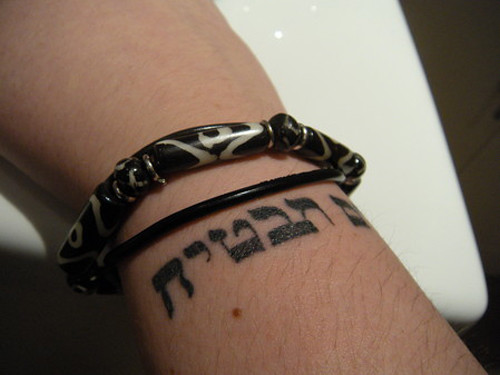Idle Hands Tattoo Biography
Source:- Google.com.pk










Appropriately, these representations of the killer whale ideologically rebuffed the pursuing walrus, in turn, extending a hunter's safe passage through dangerous waters. On the other hand, the art historian Ralph Coe believes that labret-like tattoos mimicked walrus's tusks, especially since many labrets were carved from walrus ivory:
"The ivory seems to stand for the interchangeability of the animal or human, his soul[s], and the recipient, just as the Eskimo himself thought of wood as a symbol of strength: 'to the Eskimo, dwarf willow is a symbol of strength and suppleness against an overwhelming Arctic background, where survival depends upon a man's ability to contend with the forces of nature, while at the same time yielding to them and conforming with them.'"
Adopting the anatomical characteristic of the walrus (tusks) may have ideologically captured the essence of its aggressive behavior or transformed the hunter into this creature. This would not be surprising since the concept of transformation - men into animals, animals into men, and animals into animals - permeates all aspects of life in the Bering Strait and is expressed on all kinds of objects. No doubt this deceptive "tattoo foil" subverted the attention of the foe and safeguarded the hunter from malicious attack.
Tattoo foils were not only confined to labret-like tattoos. Instead, men and women were variably tattooed on each upper arm and underneath the lip with circles, half-circles, or with cruciform elements at both corners of the mouth to disguise the wearers from disease-bearing spirits. Paul Silook explained: "[y]ou know some families have the same kind of sickness that continues, and people believed that these marks should be put on a child so the spirits might think he is a different person, a person that is not from that family. In this way people tried to cut off trouble."
The multiplicity of "guardian" forms and the various tattoo motifs related to them suggests, in all probability, that specific tattoo "remedies" were believed to differ from individual to individual, or more appropriately, from family to family. An account from a Chaplino Yupiget [Indian Point] visiting Gambell, St. Lawrence Island in 1940, reveals that this was the case, at least in mainland Siberia:
"I was the oldest child in my family. In trying to save my brothers and sisters
my father ask[ed] some woman to have me tattooed. The woman had all kinds of prayer when she tattooed me. While [a] woman [is] tattooing a person, every stitch as she goes has something to say with. My father[,] trying to save me as best he can, he put leather bands around my wrist and forehead, with beads hanging down all over my eyes, and beads on each sole of [my] stocking, stitched through...to save his child from death. Also on every joint beads are stitched, and sometimes little bells on elbows. My father sewed little pieces of squirrel's kettle on the band around my shoulders and under [my] arm. Part of parents' idea to save children."
Idle Hands Tattoo For Girls For Women Tumble Words Quotes For Men Design Designs Writing

Idle Hands Tattoo For Girls For Women Tumble Words Quotes For Men Design Designs Writing

Idle Hands Tattoo For Girls For Women Tumble Words Quotes For Men Design Designs Writing

Idle Hands Tattoo For Girls For Women Tumble Words Quotes For Men Design Designs Writing

Idle Hands Tattoo For Girls For Women Tumble Words Quotes For Men Design Designs Writing

Idle Hands Tattoo For Girls For Women Tumble Words Quotes For Men Design Designs Writing

Idle Hands Tattoo For Girls For Women Tumble Words Quotes For Men Design Designs Writing

Idle Hands Tattoo For Girls For Women Tumble Words Quotes For Men Design Designs Writing

Idle Hands Tattoo For Girls For Women Tumble Words Quotes For Men Design Designs Writing

Idle Hands Tattoo For Girls For Women Tumble Words Quotes For Men Design Designs Writing

Idle Hands Tattoo For Girls For Women Tumble Words Quotes For Men Design Designs Writing
No comments:
Post a Comment